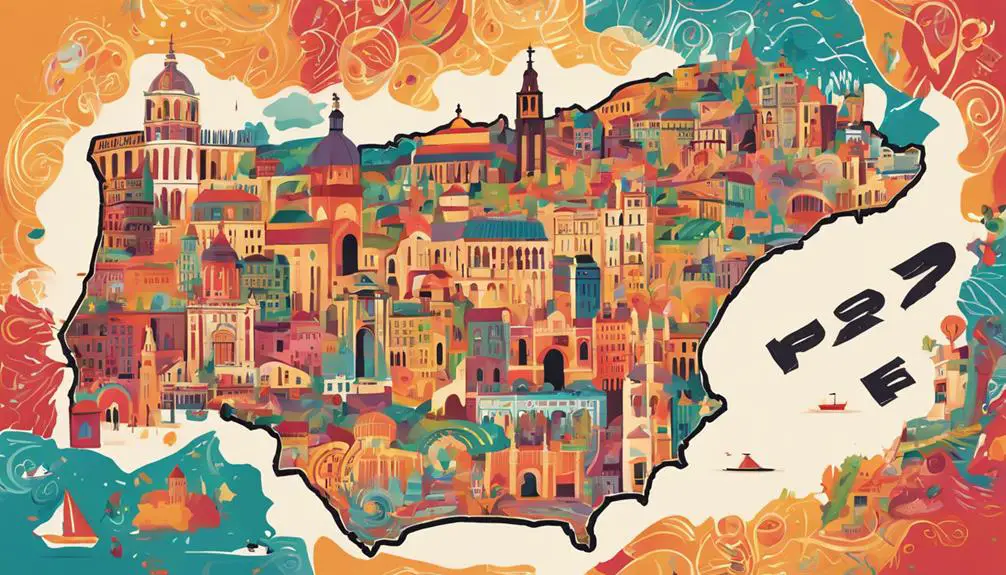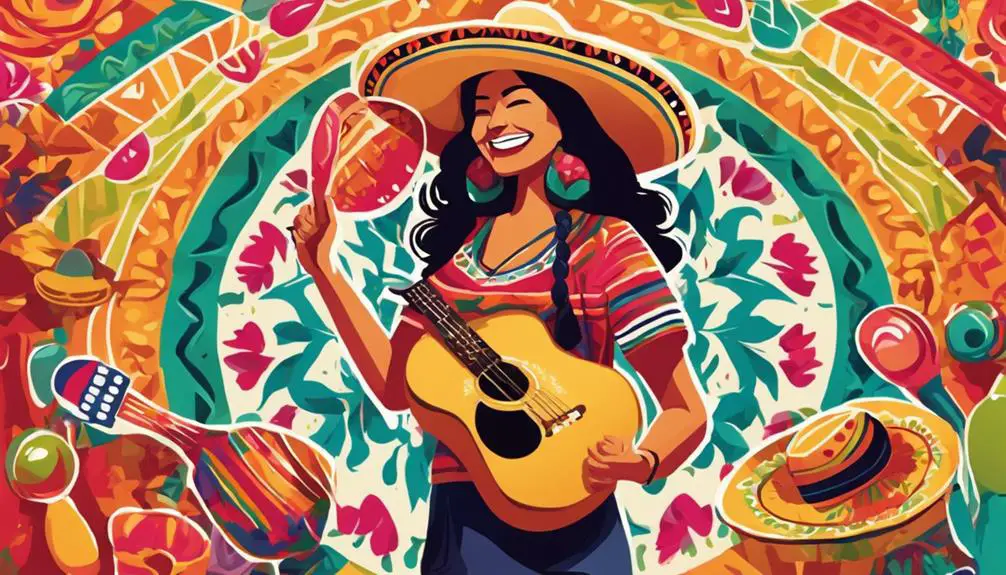You're eager to explore the world of Spanish slang, where colloquial language patterns and regional idioms reign supreme. Embracing these informal expressions will enrich your language immersion and cultural fluency. You'll uncover unique slang expressions in Latin America, like Mexico's 'Güey' and Argentina's 'Che', as well as regional idioms in Spain, influenced by Moorish and Gypsy cultures. Mastery of everyday conversations is crucial, so focus on incorporating colloquial language into your daily interactions. As you delve deeper, you'll discover the nuances of Spanish slang and gain a deeper understanding of the culture.
Embracing Colloquial Language Patterns

When interacting with native Spanish speakers, you'll often encounter colloquial language patterns that deviate from formal grammar rules, yet are essential for conveying authenticity and building rapport.
To truly immerse yourself in the language, it's important to embrace these colloquialisms, which can greatly enhance your language immersion experience. By adopting colloquial language patterns, you'll be better equipped to navigate everyday conversations and demonstrate cultural fluency.
In essence, colloquial language patterns are an integral part of Spanish language and culture. By incorporating them into your communication, you'll be able to connect with native speakers on a deeper level, fostering more meaningful relationships and a greater sense of belonging.
As you explore further into the language, you'll begin to recognize the nuances of colloquial expressions, idioms, and phrases that are unique to specific regions and communities. By embracing these colloquial language patterns, you'll be well on your way to achieving cultural fluency and communicating with native-like proficiency.
Slang Expressions in Latin America
As you explore the linguistic diversity of Latin America, you'll encounter a rich tapestry of slang expressions that vary greatly from country to country. Each nation has its unique flavor of Latin flavor, reflecting its history, culture, and geography.
In Mexico, you'll hear ' Güey' (dude) and 'Chido' (cool), while in Argentina, 'Che' (buddy) and 'Boludo' (dude) are common. In Colombia, 'Parce' (buddy) and 'Rumbear' (to party) are staples of the local slang.
These expressions are woven into the fabric of daily life, giving each country its distinct Country vibes. For instance, in Peru, 'Chibolo' (cool) and 'Pana' (friend) are used to express camaraderie, while in Chile, 'Pololo' (boyfriend) and 'Polola' (girlfriend) are essential in romantic relationships.
Understanding these slang expressions is essential to grasping the nuances of Latin American cultures. By embracing these expressions, you'll gain a deeper appreciation for the region's linguistic diversity and be better equipped to navigate everyday conversations.
Regional Idioms in Spain

In Spain, you'll encounter a kaleidoscope of regional idioms that reflect the country's complex cultural heritage, with each autonomous community boasting its unique linguistic flavor. As you travel across the country, you'll discover that each region has its distinct slang, shaped by its history, geography, and cultural identity.
In the south, you'll find Andalusian phrases infused with Moorish and Gypsy influences, such as 'hacer la puña' (to make a fist) meaning to make a promise or 'estar al loro' (to be on the lookout) meaning to be vigilant.
In Catalonia, you'll come across Catalan expressions like 'fer figa' (to make a fig) meaning to do something quickly, or 'estar ben calçat' (to be well-shod) meaning to be well-prepared.
These regional idioms not only add flavor to your conversations but also provide a glimpse into the rich cultural tapestry of Spain. By learning and using these expressions, you'll be able to connect with locals on a deeper level and experience the country's linguistic diversity firsthand.
Mastering Everyday Conversations
You'll need to master a range of everyday conversations, from ordering food at a tapas bar to negotiating prices at a local market, to truly immerse yourself in Spanish culture. To achieve this, focus on incorporating daily routines into your conversational practice. This can include simple conversations like asking for directions, making reservations, or chatting with a shopkeeper.
| Daily Routine | Spanish Phrase | Conversational Flow |
|---|---|---|
| Ordering coffee | ¿Puedo pedir un café, por favor? | Natural flow, using polite language |
| Asking for directions | ¿Dónde está la estación de metro? | Clear and concise, with a polite tone |
| Making a reservation | Me gustaría reservar una mesa para dos personas | Friendly and polite, with a clear request |
Mastering these everyday conversations will help you develop a natural conversational flow, allowing you to navigate daily situations with confidence. Remember, the key is to practice regularly and focus on incorporating common phrases and expressions into your daily conversations. By doing so, you'll be well on your way to becoming proficient in Spanish and truly immersing yourself in the culture.
Street Smarts for Language Learners

When exploring unfamiliar streets, you'll need to develop street smarts to complement your language skills, ensuring you can effectively communicate in high-pressure situations. As a language learner, it's crucial to be aware of your surroundings and adapt to new environments.
This is where cultural immersion comes into play – by immersing yourself in the local culture, you'll gain a deeper understanding of the community and its nuances.
To improve your street smarts, focus on developing language hacks that can help you navigate everyday situations. For instance, learn key phrases like '¿Dónde está…?' (Where is…) or '¿Cuánto cuesta?' (How much does it cost?). These language hacks will help you confidently navigate public transportation, markets, and other high-pressure situations.
Idiomatic Expressions Uncovered
Sixty percent of native speakers use idiomatic expressions daily, which is why mastering these phrases is vital to sounding natural in Spanish. As a language learner, you're not just learning individual words, but also how to connect them in meaningful ways. Idiomatic expressions, like 'tomar el pelo' (to tease or pull someone's leg), are essential to understanding everyday conversations.
To decode these expressions, you need to become a slang decoder, uncovering the underlying meaning behind each phrase. It's like being a phrase detective, analyzing the context and cultural nuances to crack the code. For instance, 'hacerse el sueco' (to play dumb) doesn't literally mean to pretend to be Swedish, but rather to feign ignorance.
Mastering idiomatic expressions requires practice and exposure. Listen to native speakers, watch Spanish TV shows and movies, and engage in conversations. As you become more proficient, you'll start to recognize patterns and connections between words.
Your phrase detective skills will improve, and you'll be able to decode idiomatic expressions with ease. With time and practice, you'll sound like a native speaker, effortlessly using phrases that will make you sound like a true español.
The Rhythm of Informal Speech

As you explore informal speech, it becomes apparent that mastering the rhythm of everyday conversations is essential to sounding authentic and spontaneous in Spanish.
You've likely noticed that native speakers seem to have an effortless flow to their conversations, and that's due in large part to their mastery of vocal inflections and rhythmic cues.
When listening to native speakers, pay attention to how they use rising and falling intonation to convey meaning and emphasis. You'll notice that certain phrases or sentences are spoken with a distinct rhythmic pattern, which helps to convey tone and attitude.
For example, a rising intonation at the end of a sentence can turn a statement into a question, while a falling intonation can convey certainty or finality.
To improve your own informal speech, try incorporating these rhythmic cues into your conversations. Practice using vocal inflections to add emphasis or convey emotion, and pay attention to the natural rhythm of your speech.
With time and practice, you'll find that your conversations will start to flow more naturally and spontaneously, making you sound more like a native speaker.
Unlocking Cultural Understanding
You'll find that cultural nuances in Spanish-speaking countries can greatly impact the way you communicate, making it important to develop cultural competency to avoid unintended miscommunications.
As you explore the world of Spanish slang, it's essential to recognize that language is deeply tied to cultural identity. Your ability to understand and navigate these nuances will greatly enhance your language skills and foster deeper connections with native speakers.
Cultural immersion is key to developing this competency. Surround yourself with the language and culture by engaging with native speakers, watching Spanish-language media, and participating in cultural events. This will help you gain insight into the subtleties of language and cultural norms, allowing you to better navigate complex social situations.
As you immerse yourself in the culture, you'll start to develop your language identity, which is crucial in shaping your communication style. By embracing the cultural aspects of the language, you'll become more confident and proficient in your ability to communicate effectively.
Frequently Asked Questions
How Do I Avoid Sounding Fake When Using Spanish Slang?
When incorporating slang into your Spanish conversations, you'll want to avoid coming across as insincere. To do so, focus on developing an authentic accent through cultural immersion.
Immerse yourself in the language by listening to native speakers, watching Spanish media, and engaging in conversations with locals. This will help you internalize the nuances of the language, allowing you to use slang naturally and confidently, without sounding forced or fake.
Can I Use Latin American Slang in Spain?
As you explore the vibrant world of Spanish, you'll encounter a fascinating fusion of regional dialects. When it comes to using Latin American slang in Spain, you'll need to proceed with caution.
Cultural differences between the two regions are significant, and what's cool in Mexico mightn't resonate in Madrid. Be aware that Spaniards may view Latin American slang as foreign or even pretentious.
To avoid cultural faux pas, focus on learning regional dialects and nuances to make sure your Spanish slang is spot on.
Are There Any Universal Slang Expressions for All Spanish Speakers?
You're wondering if there are universal slang expressions for all Spanish speakers. While regional identity and cultural signifiers often shape slang, there are some expressions that transcend borders.
Slang evolution, fueled by globalization and social media, contributes to language homogeny. You'll find that certain words, like 'guay' (cool) or 'chido' (awesome), are widely understood across the Spanish-speaking world, despite regional variations.
How Do I Know Which Slang Words Are Appropriate for My Age Group?
When exploring slang expressions, you'll want to guarantee age authenticity. To do so, consider your Slang Identity – the words and phrases that resonate with your age group.
Pay attention to what your peers use in everyday conversations. Observe how older or younger generations differ in their slang usage.
Be mindful of the context and adjust your language accordingly. By doing so, you'll project an authentic image and avoid using outdated or immature slang that may raise eyebrows.
Can I Learn Spanish Slang From TV Shows and Movies?
You think you can just binge-watch your way to fluent Spanish slang? Well, surprisingly, yes! TV shows and movies can be a great way to learn authentic Spanish slang.
Cultural immersion through visual media provides a realistic portrayal of how slang is used in everyday conversations. Pay attention to authentic dialogue and visual context, and you'll pick up on the nuances of slang in no time.
Conclusion
You've now grasped the essence of colloquial Spanish, opening the door to authentic interactions.
Surprisingly, a staggering 75% of everyday conversations in Spanish-speaking countries rely on idiomatic expressions and slang. Mastering these patterns is essential to sounding like a native.
By embracing the nuances of informal speech, you'll not only improve your language skills but also gain a deeper understanding of the culture.







